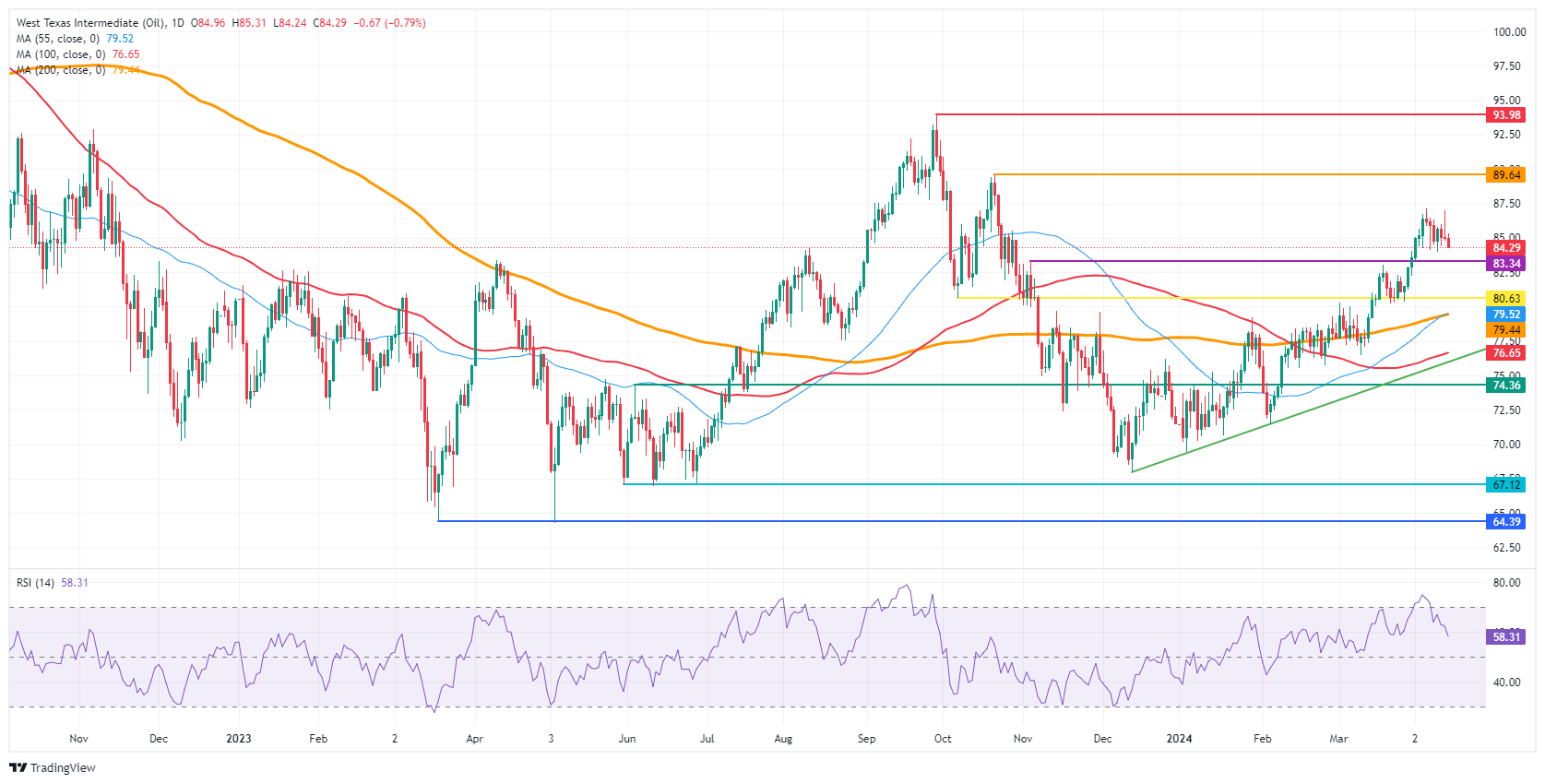Oil drops despite mounting geopolitical tensions over the weekend
- WTI Oil drops below $85 after Iran’s drone attack on Israel ended without any massive effects.
- Oil price set to test support at $84.25 ahead of headline-driven week.
- The US Dollar Index slides below 106.00 as risk on sentiment seems to be taking over.
Oil prices retreat on Monday as markets heaved a big sigh of relief after the Iranian retaliation against Israel was well-communicated and led to very little damage, with investors hopeful that any escalation will prove contained. During the weekend, the attack took place, consisting of a drone and missile attack, from which more than 99% got neutralised by defence systems. Meanwhile, Iran has said it is not seeking further escalation and even the US has already been in touch with Iran, which means the diplomatic machine is working to avoid further escalation.
The US Dollar, meanwhile, is sliding below 106.00 with some outflows out of the Greenback. Global markets seem to be recovering, with all equities across the board in the green, weighing on safe-haven assets such as the US Dollar. Looking at the economic calendar, traders can gear up for the US Retail Sales numbers on Monday.
Crude Oil (WTI) trades at $84.29 and Brent Crude at $89.07 at the time of writing.
Oil news and market movers: Sigh of relief
- Goldman Sachs Analyst Daan Struyven said to Bloomberg that a $5 to $10 risk premium should be added into the Oil prices when the Israel-Iran situation further escalates.
- Iran has already come out on Monday morning to say it is not looking for further escalation of tensions in the Middle East.
- Overall risk on sentiment rolls through markets after tensions in the Middle East are easing.
- Upside risk to Oil prices remain in the coming weeks in case of any Oil embargoes against Iran as the country is the third-largest producer within OPEC.
Oil Technical Analysis: Easing for now with tail risk in mind
Oil prices are easing on Monday after markets scale back the risk premium in Oil that got priced in ahead of the weekend. With investors applauding the deescalation, a test towards $83.34 (purple line) is key. In case that line snaps, expect to see further falls towards $80 as more risk premium is priced out.
In case tensions escalate again and last week’s high at $87.12 gets broken, the $90 handle should come into grasp. One small barrier in the way is $89.64, the peak from October 20. In case of further escalating tensions in the Middle East, expect even $94 to become a possibility, and a fresh 18-month high could be on the cards.
On the downside, $83.34 is the first level to have a look for after a very clean break and test for support on April 1 and 2. Should it not hold, $80.63 is the next best candidate as a pivotal supportive level. A touch softer, the convergence with the 55-day and the 200-day Simple Moving Averages (SMAs) at $79.32 should halt any further downturn.
US WTI Crude Oil: Daily Chart
WTI Oil FAQs
WTI Oil is a type of Crude Oil sold on international markets. The WTI stands for West Texas Intermediate, one of three major types including Brent and Dubai Crude. WTI is also referred to as “light” and “sweet” because of its relatively low gravity and sulfur content respectively. It is considered a high quality Oil that is easily refined. It is sourced in the United States and distributed via the Cushing hub, which is considered “The Pipeline Crossroads of the World”. It is a benchmark for the Oil market and WTI price is frequently quoted in the media.
Like all assets, supply and demand are the key drivers of WTI Oil price. As such, global growth can be a driver of increased demand and vice versa for weak global growth. Political instability, wars, and sanctions can disrupt supply and impact prices. The decisions of OPEC, a group of major Oil-producing countries, is another key driver of price. The value of the US Dollar influences the price of WTI Crude Oil, since Oil is predominantly traded in US Dollars, thus a weaker US Dollar can make Oil more affordable and vice versa.
The weekly Oil inventory reports published by the American Petroleum Institute (API) and the Energy Information Agency (EIA) impact the price of WTI Oil. Changes in inventories reflect fluctuating supply and demand. If the data shows a drop in inventories it can indicate increased demand, pushing up Oil price. Higher inventories can reflect increased supply, pushing down prices. API’s report is published every Tuesday and EIA’s the day after. Their results are usually similar, falling within 1% of each other 75% of the time. The EIA data is considered more reliable, since it is a government agency.
OPEC (Organization of the Petroleum Exporting Countries) is a group of 13 Oil-producing nations who collectively decide production quotas for member countries at twice-yearly meetings. Their decisions often impact WTI Oil prices. When OPEC decides to lower quotas, it can tighten supply, pushing up Oil prices. When OPEC increases production, it has the opposite effect. OPEC+ refers to an expanded group that includes ten extra non-OPEC members, the most notable of which is Russia.







